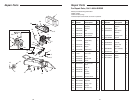
76
Safety Instructions (continued)
Find and read all warning labels found on
the air compressor shown below
Warning Labels
ASME Safety Valve
A safety valve that automatically releases
the air if the air receiver (tank) pressure
exceeds the preset maximum.
PSI (Pounds per Square Inch)
Measurement of the pressure exerted by
the force of the air. The actual psi output
is measured by a pressure gauge on the
compressor
SCFM (Standard Cubic Feet per
Minute)
Sometimes called CFM (Cubic Feet per
Minute). Measurement of air volume
delivered by the compressor.
Air Delivery
A combination of psi and SCFM. The air
delivery required by a tool is stated as
(number) SCFM at (number) psi. The
combination of these figures determines
what size unit is needed.
Air Tank Capacity
The volume of air stored in the tank and
available for immediate use. A large tank
allows the intermittent use of an air tool
with an air requirement higher than the
compressor’s rated delivery.
Volts or Voltage
A measurement of the force of an electri-
cal current.
Amps or Amperage
A measure of the electrical force minus
the resistance on an electrical line.
Ridgid air compressors require 15 amps
for operation. Be sure the compressor
will operate on an electrical line with the
proper amps. If other appliances operate
on the same line, they will reduce the
available amps. If the amperage is not
adequate, the result will be blown fuses
or tripped circuits.
Regulator
A control that adjusts the line pressure to
the proper amount needed to operate
spray guns and air tools.
Tank Pressure Gauge
Indicates tank pressure in psi.
Line Pressure Gauge
Displays the current line pressures. It is
regulated by the regulator knob.
Cut-in/Cut-off Pressure
Specific psi at which a compressor starts
and stops while refilling the air tank.
Glossary of Terms
DK724100AV 10003
Figure 1















